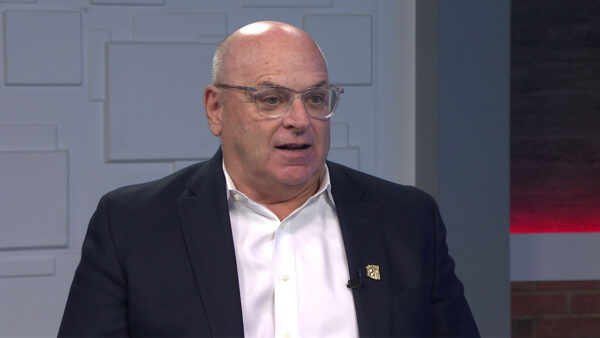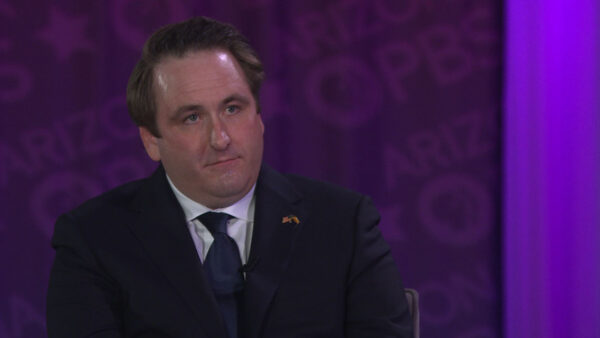A new survey by the Arizona Hospital and Healthcare Association shows that care given to those unable to pay their bill has fallen 31 percent for the first four months of this year as compared to the same time period last year. Jim Haynes, senior vice president and chief operating officer for the association, will talk about the new survey.
Ted Simons: A new survey by the Arizona hospital and health care association shows that uncompensated care has fallen in the first four months of this year as compared to the same time last year. Jim Haynes is senior vice president and chief operating officer for the association. He joins us now. Good to have you here. Thank you for joining us.
Jim Haynes: You're welcome.
Ted Simons: This survey was done by the association, correct?
Jim Haynes: It certainly was.
Ted Simons: What were you looking for?
Jim Haynes: Back in July 2011, when the state was having real budgetary problems, they put a freeze on the childless adult population. When that happened, our hospitals were really concerned about what is that going to do to our uncompensated care and we started to survey members at that point. The first survey we completed was in October, and it showed that uncompensated care went from 3.5% of charges to 6%, it almost doubled overnight. We have been tracking that every month since then and it had gone up to 8%. It is a large number. We continue to track that. See what the results are. Since January 1st, it has gone down a lot.
Ted Simons: Some of the numbers are amazing. Uncompensated care down 31% in the first four months.
Jim Haynes: Absolutely. We kind of expected that it would go down quickly. Typically what happens is someone comes in the hospital, doesn't have insurance, and you try to see if you can find insurance for them and see if they qualify for the access program. And since January 1st, the number of people that are covered, childless adult population, has gone from 68,000 in December of 2013, to 235,000. So it has been a big increase, a huge increase and that is the reason why the uncompensated care has dropped.
Ted Simons: Before we get too much further, define uncompensated care. What are the parameters here?
Jim Haynes: What it is, is somebody comes in the hospital and they don't have the ability to pay. They just don't have the dollars. They don't have the money. That's called charity care. That is part of uncompensated care. The other portion of it is people who choose not to pay. They have other responsibilities. They choose not to pay their hospital bill. They call that bad debt. Uncompensated care is a combination of those two items.
Ted Simons: Again, with 31% down, judging from what I saw, 170 million written off versus maybe 240, $250 million written off last year.
Jim Haynes: Those are the numbers. Pretty significant.
Ted Simons: What does that do to operating margins for hospitals?
Jim Haynes: It has helped a lot. It almost goes dollar for dollar, so hospitals' operating margins have gone up about one percent which doesn't sound like a lot but it is a big number. That is a good thing. It gives an ability to put money back into the operations, finance capital, all of those kinds of things that are important to provide care to residents of Arizona.
Ted Simons: You mentioned January 1st, as being the time when it seemed like things changed. Obviously we saw expansion of access. Is this a direct correlation to expanding access?
Jim Haynes: No question in my mind at all. As I said before, when the population was frozen, it went up immediately. And now that the population, people do qualify, can be added to the access insurance again, it started to go down directly. I don't think there is any question that has had a direct correlation.
Ted Simons: Is there any way in the future or now you can get a specific metric that can be more specific or you can say it seems pretty obvious as opposed to there it is right there.
Jim Haynes: I don't think there is any question. There it is right there.
Ted Simons: So obvious you don't need anymore metrics.
Jim Haynes: I don't think so.
Ted Simons: The impact of the Affordable Care Act, just generally speaking, more people insured. Making a difference?
Jim Haynes: It's too early to tell at this point for that. We certainly expect it will. It is hard to imagine it won't. But at this point in time it is too early to tell.
Ted Simons: As far as ERs, are they seeing fewer patients?
Jim Haynes: No, ED volumes are still -- I don't expect it to be a huge change there at least immediately. Over time, you think it will. You think people will be able to go to the physicians' offices as opposed to ED. And hopefully that'll be the case, but it's too early to tell on that one.
Ted Simons: Why are you not surprised or didn't expect to see a change on that because I think most people would.
Jim Haynes: We expected to see a change on that several years ago when we first went into HMOs. It didn't happen at that point in time. So, it's -- people need care, want care right away. And EDs are very convenient for that.
Ted Simons: Regardless of the insurance situation.
Jim Haynes: That's correct.
Ted Simons: In a -- I know that assessments are now supposed to be helping pay for the access expansion. What are we seeing as far as what hospitals are paying in those assessments?
Jim Haynes: For the first six months, it was about $75 million that hospitals paid. And for 2015, the amount to $235 million. It is a lot of money. The key question there though is there -- two parts to it. One is by providing this, people get coverage. That's a great thing. Uncompensated care is down. That is a great thing. But there's also another part to that assessment, that is we're supposed to start seeing additional patients. It's still too early to evaluate that at this point in time. We think that is going to be the case, but we don't know. If it turns out that we don't see an increase, or hospitals don't see an increase in volume, we will address that, assessment will go down, if that's the case. It does tie directly to what the cost of caring for those patients are.
Ted Simons: And compare that now, if you can, to how much the feds are paying as far as expanding access. Obviously there is a formula here and cooperation here and a couple of different avenues. What are you seeing out there?
Jim Haynes: A great program for the state. The way it works is -- in Arizona, almost a two for one, if we put up $1,000, the fed puts up $2,000. So it is a great return on investment. Bringing Arizona dollars back to Arizona. It is a great program. It is a good thing.
Ted Simons: Okay. As far as what we're seeing from the feds, whatever we're seeing, you're saying is a good thing.
Jim Haynes: Absolutely.
Ted Simons: Okay. Critics are saying things are going well for the hospitals. Things are turning around for the hospitals. Are hospitals lowering their costs to patients?
Jim Haynes: Two things on that. First I will say when we do our survey, 30% of the hospitals were still reporting that they were losing money on operations. That is a lot of hospitals losing money on operations.
Ted Simons: Stop there. Why?
Jim Haynes: Just a lot of things going on as far as first we haven't had rate increases from the access program for years. Right now we're not getting paid full costs from the access program for taking care of patients. In addition, Affordable Care Act has a couple of components to it. They're reducing some of the payments that they're making to hospitals. And the whole part of that was they're reducing those payments to hospitals, but hospitals were getting that back by seeing additional patients. And that is when we still have to see if that is going to happen. Not only additional payments, but lower uncompensated care, and we just have to play that out and see how that plays out.
Ted Simons: And was there a second point you were going to make or did you get that one in there?
Jim Haynes: I think I got that one in there.
Ted Simons: Okay. So, the impact of the expansion and I know Affordable Care Act is still early, and, as you mentioned, moving parts still on that. But the impact on hospital bottom lines in general, you got some folks still losing money out there. What -- what do you see in the future?
Jim Haynes: I think what we will see is hospitals really working hard to decrease their costs. They have been working hard to do that. Maintaining high quality, or improving quality, but also reducing costs, that is the name of the game in the future. Hospitals are going to have to do that.
Ted Simons: Do you see as far as any other states, can you compare and contrast -- I thought Colorado had something interesting you can compare to. Seeing anything out there?
Jim Haynes: The states that did expand are seeing reduction uncompensated care. Exactly what you would expect. Those that didn't, are still seeing the same uncompensated care levels they had before.
Ted Simons: And the next survey will be…??
Jim Haynes: We do it on a monthly basis. The next big survey where we look and see what is the impact -- what additional patient are we seeing? We will see that probably towards the end of the summer.
Ted Simons: Who's who exactly is showing up now in other words.
Jim Haynes: Absolutely.
Ted Simons: Along with how many.
Jim Haynes: Yes.
Ted Simons: Good information. It's good to have you here. Thanks for joining us.
Jim Haynes: Thank you.
Jim Haynes:Senior Vice President and Chief Operating Officer, Arizona Hospital and Healthcare Association;






















